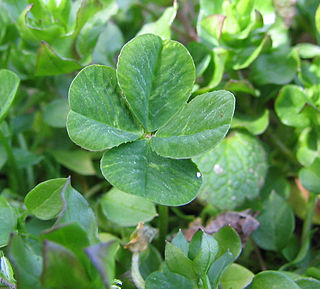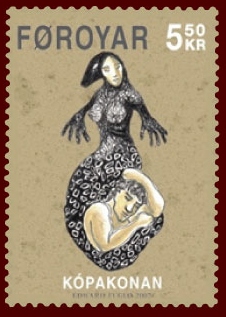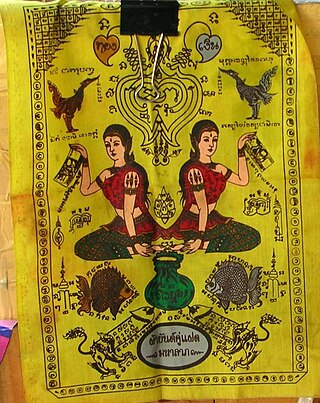Related Research Articles

Luck is the phenomenon and belief that defines the experience of improbable events, especially improbably positive or negative ones. The naturalistic interpretation is that positive and negative events may happen at any time, both due to random and non-random natural and artificial processes, and that even improbable events can happen by random chance. In this view, the epithet "lucky" or "unlucky" is a descriptive label that refers to an event's positivity, negativity, or improbability.

The hand is a non-SI unit of measurement of length standardized to 4 in (101.6 mm). It is used to measure the height of horses in many English-speaking countries, including Australia, Canada, Ireland, the United Kingdom, and the United States. It was originally based on the breadth of a human hand. The adoption of the international inch in 1959 allowed for a standardized imperial form and a metric conversion. It may be abbreviated to "h" or "hh". Although measurements between whole hands are usually expressed in what appears to be decimal format, the subdivision of the hand is not decimal but is in base 4, so subdivisions after the radix point are in quarters of a hand, which are inches. Thus, 62 inches is fifteen and a half hands, or 15.2 hh.

The evil eye is a supernatural belief in a curse brought about by a malevolent glare, usually inspired by envy. The belief in the evil eye among humans has existed since prehistory, and amulets to protect against it have been found dating to about 5,000 years ago. It is estimated that around 40% of the world's population believes in the evil eye.

English folklore consists of the myths and legends of England, including the English region's mythical creatures, traditional recipes, urban legends, proverbs, superstitions, and folktales. Its cultural history is rooted in Celtic, Christian, Nordic and Germanic folklore.

A fairy ring, also known as fairy circle, elf circle, elf ring or pixie ring, is a naturally occurring ring or arc of mushrooms. They are found mainly in forested areas, but also appear in grasslands or rangelands. Fairy rings are detectable by sporocarps in rings or arcs, as well as by a necrotic zone, or a ring of dark green grass. Fungus mycelium is present in the ring or arc underneath. The rings may grow to over 10 metres (33 ft) in diameter, and they become stable over time as the fungus grows and seeks food underground.

A black cat is a domestic cat with black fur that may be a specific breed, or a common domestic cat of no particular or mixed breed. All-black fur pigmentation is slightly more prevalent in male cats than female cats. Most black cats have golden irises due to their high melanin pigment content. Black cats are the subject of myth, legend, and superstition. They are often associated with witches and bad luck in European folklore.

Selkies are mythological creatures that can shapeshift between seal and human forms by removing or putting on their seal skin. They feature prominently in the oral traditions and mythology of various cultures, especially those of Celtic and Norse origin. The term “selkie” derives from the Scots word for “seal”, and is also spelled as silkies, sylkies, or selchies. Selkies are sometimes referred to as selkie folk, meaning 'seal folk'. Selkies are mainly associated with the Northern Isles of Scotland, where they are said to live as seals in the sea but shed their skin to become human on land.

In some cultures, a rabbit's foot is carried as an amulet believed to bring good luck. This belief is held by people in a great number of places around the world, including Europe, China, Africa, Australia and North and South America. In variations of this superstition, the rabbit it came from must possess certain attributes, such as having been killed in a particular place, using a particular method, or by a person possessing particular attributes.
"Rabbit rabbit rabbit" is a superstition found in Britain and North America wherein a person says or repeats the words "rabbit", "rabbits" and/or "white rabbits" aloud upon waking on the first day of a month, to ensure good luck for the rest of it.
Japanese superstitions are rooted in the culture and history of Japan and the Japanese people. Some Japanese superstitions are meant to teach lessons or serve as practical advice.

Russian traditions and superstitions include superstitions and folk rituals of the Russian community. Many of these traditions are staples of everyday life, and some are even considered common social etiquette despite being rooted in superstition. The influence of these traditions and superstitions vary, and their perceived importance depends on factors such as region and age.

A duende is a humanoid figure of folklore, with variations from Iberian, Ibero American, and Latin American cultures, comparable to dwarves, gnomes, or leprechauns. In Spanish duende originated as a contraction of the phrase dueñ(o) de casa, effectively "master of the house", or perhaps derived from some similar mythical being of the Visigoth or Swabian culture given its comparable looks with the “Tomte” of the Swedish language conceptualized as a mischievous spirit inhabiting a dwelling.
According to folklore a fairy path is a route taken by fairies usually in a straight line and between sites of traditional significance, such as fairy forts or raths, "airy" (eerie) mountains and hills, thorn bushes, springs, lakes, rock outcrops, and Stone Age monuments. Ley lines and spirit paths, such as with corpse roads, have some similarities with these fairy paths. A fairy ring is also a path used by fairies, but in a circle, for dancing, as described by poet W. B. Yeats, "...the fairies dance in a place apart, Shaking their milk-white feet in a ring,..." The concept is usually associated with Celtic folklore, especially that of Ireland.

European folklore or Western folklore refers to the folklore of the Western world, especially when discussed comparatively. The history of Christendom during the Early Modern period has resulted in a number of traditions that are shared in many European ethnic and regional cultures.

A superstition is any belief or practice considered by non-practitioners to be irrational or supernatural, attributed to fate or magic, perceived supernatural influence, or fear of that which is unknown. It is commonly applied to beliefs and practices surrounding luck, amulets, astrology, fortune telling, spirits, and certain paranormal entities, particularly the belief that future events can be foretold by specific unrelated prior events.
Superstition in Pakistan is widespread and many adverse events are attributed to the supernatural effect. Superstition is a belief in supernatural causality: that one event leads to the cause of another without any physical process linking the two events, such as astrology, omens, witchcraft, etc., that contradicts natural science. In Pakistan, the Magical thinking pervades as many acts and events are attributed to supernatural and ritual, such as prayer, sacrifice, or the observance of a taboo are followed. Many believe that magic is effective psychologically as it has placebo effect to psychosomatic diseases. Scholars of Islam view superstition as shirk, denying the unity of God and against Sharia. Within Islam, shirk is an unforgivable crime; God may forgive any sins if one dies in that state except for committing shirk. Sleeping on your right side and reciting the Ayat-ul-Kursi of the Quran can protect person from the evil.

Thai folklore is a diverse set of mythology and traditional beliefs held by the Thai people. Most Thai folklore has a regional background for it originated in rural Thailand. With the passing of time, and through the influence of the media, large parts of Thai folklore have become interwoven with the wider popular Thai culture.

While Serbia is primarily a religious country and approximately 85% of Serbs are Serbian Orthodox, superstition in Serbia continues to have an effect on its culture in mostly rural parts of the country, where the older generation resides. Serbia was a Pagan country before the 9th century, which is when superstitious belief was formed. After the ending of the Cold War and the subsequent end of the communist rule in Serbia, religion flourished again, and with it, superstition. Serbian people share common superstitions with other European countries surrounding it, especially around the Balkan area. However, Serbia also has national superstitions that have been created and believed throughout its own cultural history. These beliefs are much more diverse than other countries in the Balkans. These superstitions have influenced how Serbs think and act around animals or in terms of mundane chores for centuries.
References
- 1 2 3 4 Boas, Franz (1917). "Journal of American Folk-lore Volume XXX". Journal of American Folklore. 30–31.
- 1 2 3 4 5 6 The Frank C. Brown Collection of North Carolina Folklore Vol. VII. Belden, Henry M., Brown, Frank Clyde., White, Newman Ivey, 1892-1948., North Carolina Folklore Society. Durham, N.C.: Duke University Press. 1952–1964. ISBN 978-0822302599. OCLC 17961558.
{{cite book}}: CS1 maint: others (link) - 1 2 3 4 5 6 Hand, Wayland D. (1962). "A Miscellany of Nebraska Folk Beliefs". Western Folklore. 21 (4): 257–278. doi:10.2307/1496102. JSTOR 1496102.
- 1 2 3 4 5 Vance, Randolph (1964). Ozark Magic and Folklore . New York, N.Y.: Dover Publications. ISBN 978-0486211817. OCLC 224665.
- 1 2 3 4 5 6 Cannell, Margaret, "Signs, Omens, and Portents in Nebraska Folklore" (1933). University of Nebraska Studies in Language, Literature, and Criticism. 2. <http://digitalcommons.unl.edu/englishunsllc/2>
- 1 2 3 4 5 6 7 Encyclopædia of superstitions, folklore, and the occult sciences of the world : a comprehensive library of human belief and practice in the mysteries of life. Daniels, Cora Linn, 1852-, Stevens, C. M. (Charles McClellan), 1861-1942. Honolulu: University Press of the Pacific. 2003. ISBN 978-1410209146. OCLC 312507567.
{{cite book}}: CS1 maint: others (link)